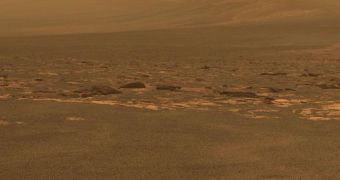The NASA Mars Exploration Rover (MER) Opportunity has finally reached the western rim of the massive Endeavour Crater, on the surface of the Red Planet. The robot has been traveling towards this objective for nearly three years, and mission controllers were reluctant they would ever get there.
However, the impressive explorations robot proved capable of braving all the hardship Mars threw its way. Considering that it has been driving backwards with one wheel off the ground for many years, the fact that its odometer managed to exceed 33 kilometers is an impressive feat.
Opportunity made its way to a location named Spirit Point – after the rover's twin spacecraft – on August 9. Its vantage point was selected using data provided by the NASA Mars Reconnaissance Orbiter (MRO) and the Mars Odyssey mission.
The rover traveled in excess of 13 miles (21 kilometers) since mission controllers at the NASA Jet Propulsion Laboratory (JPL), in Pasadena, California, decided to head out of Victoria Crater. This was the robot's home for several years.
At 14 miles (22 kilometers) in diameter, the new target for exploration is more than 25 times wider than Victoria, and deeper too. This will allow Opportunity to peer even deeper into the Red Planet's geological history, in its attempt to determine whether Mars ever had liquid water on its surface.
MRO data indicate the presence of clay minerals inside the large crater, which is tantalizing because these minerals only form in the presence of liquid water. Scientists now widely argue that Mars went through a wetter and warmer period billions of years ago.
“We're soon going to get the opportunity to sample a rock type the rovers haven't seen yet,” explains JPL MER science team member Matthew Golombek. Like his colleagues, he too is anxious to get to work in analyzing the information Endeavour Crater has to offer.
“Clay minerals form in wet conditions so we may learn about a potentially habitable environment that appears to have been very different from those responsible for the rocks comprising the plains,” the expert goes on to say.
The fact that Opportunity managed to reach Endeavour after such a long trek “is a reminder that these rovers have continued far beyond the original three-month mission,” says JPL MER project manager John Callas.
“NASA is continuing to write remarkable chapters in our nation’s story of exploration with discoveries on Mars and trips to an array of challenging new destinations,” NASA Administrator Charles Bolden said in a recent statement.
“Opportunity’s findings and data from the upcoming Mars Science Laboratory will play a key role in making possible future human missions to Mars and other places where humans have not yet been,” he concluded.

 14 DAY TRIAL //
14 DAY TRIAL //